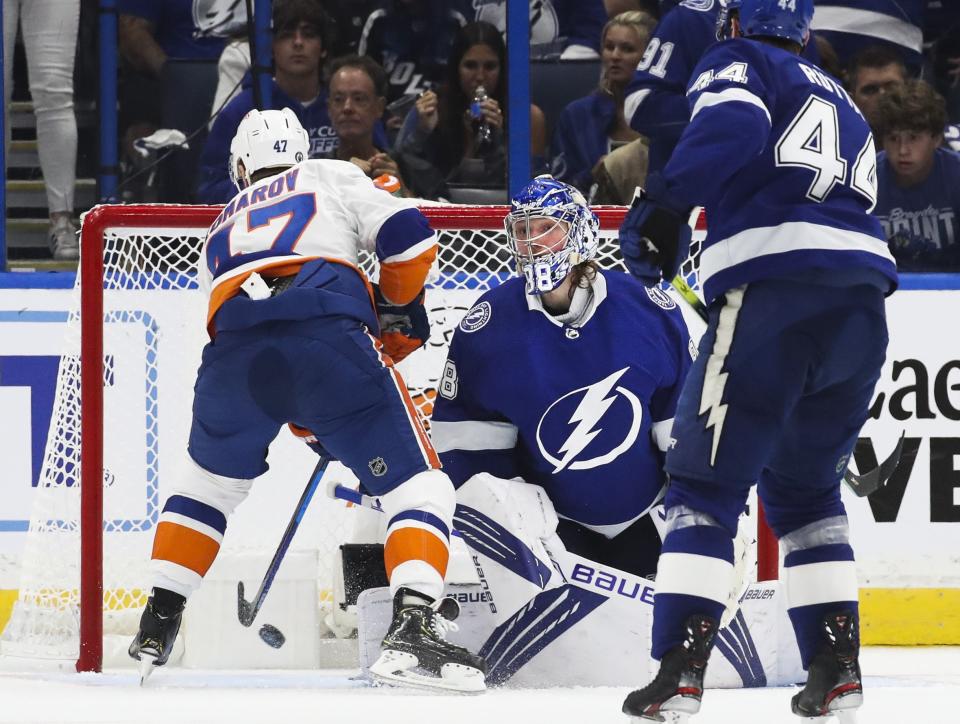Lightning-Islanders Game 1 report card: Turnabout is fair play
What a difference a season makes.
Nine months after trouncing the Islanders 8-2 in Game 1 of the Eastern Conference final inside the Edmonton bubble, the Lightning fell 2-1 to New York in the opening game of their Stanley Cup semifinal series Sunday at Amalie Arena.
If you’re counting, that’s a seven-goal swing from one series-opener to the next.
Brayden Point scored the first Tampa Bay goal in both games. A year ago, it happened just over a minute into the contest. Sunday, it came in the final minute.
Of course, the opening game of last season’s series was an anomaly, as four of the six games in the series were decided by two goals or fewer, the final two in overtime.
Games against the Islanders typically are tight-checking, low-scoring affairs, and Sunday’s was no exception.
New York has good structure, is aggressive in all three zones and plays well with a lead. Rather than stepping up, it’s defense sags, limiting the chances of chipping the puck behind them and creating odd-man rushes. It pressures the puck and thrives on turnovers.
For much of Game 1, Tampa Bay played into the Islanders’ hands, with seven giveaways to New York’s one.
The Islanders managed the puck better than the Lightning, which made too many poor decisions, and mostly stayed out of the penalty box, allowing Tampa Bay to get its league-best power-play unit on the ice only twice, the second time in the final minute.
The loss could partly be attributed to rust — the Lightning hadn’t played since Tuesday, their longest stretch without a game this postseason. A more likely explanation might be difficulty adjusting to a new opponent with a different style of play in a new series, particularly one it hadn’t seen all season.
Tampa Bay will make adjustments as the series moves forward, but clearly this isn’t the way it wanted to start.
Grade: C-minus
Here’s how we graded the rest of the Lightning’s performance in Game 1 :
Chain lightning
Steven Stamkos’ inability to get the puck deep into the Islanders’ zone was one of the first links in a chain that led to Mathew Barzal’s game-opening goal late in the second period.
Stamkos tried to make a play from just inside the offensive blue line but turned the puck over to Josh Bailey. Bailey fired the puck up the ice to Barzal, who got a step on Lightning defenseman Jan Rutta and beat Andrei Vasilevskiy between the legs as the goaltender tried to poke the puck off his stick.
But the opportunity was created even earlier for New York, during a line change.
Tampa Bay defenseman Ryan McDonagh came off the ice, leaving the whole right side of the ice open. Barzal jumped on in place of Brock Nelson, and Bailey connected with Barzal with a tape-to-tape pass as he hit the ice with a head of steam.
Lightning fast, the puck was in the back of the net.
Grade: D
No cause for concern
Surface-level analysis: Vasilevskiy was outplayed by the Islanders’ Semyon Varlamov and should have stopped one, if not both, of the goals scored against him.
Deeper dive: Vasilevkiy, who stopped 29 of the 31 shots he faced, bailed out his teammates with big saves for much of the game and faced more difficult chances than his counterpart in net.
No question, Vasilevskiy would have liked to have Ryan Pulock’s game-winning goal back, a shot from the right point that Vasilevskiy saw clearly. But his teammates hung him out to dry on Barzal’s goal, and the Lightning only stayed as close as they did for most of the game because Vasilevskiy:
• Made a right pad save on a Jean-Gabriel Pageau one-timer from low in the left circle, then stretched to his left to get a glove on a Kyle Palmieri chance from in front after Pageau fed him the puck from below the goal line in the first period.
• Deflected a Casey Cizikas redirection of a Nick Leddy shot from the left point with Ross Colton obstructing his view later in the period.
• Stopped an Anthony Beauvillier backhander after a Point turnover at the Lightning blue line early in the second.
• Made a blocker save on Barzal in the second after Barzal beat Victor Hedman with an inside-outside move. To name a few.
There’s no reason to worry about the Lightning goaltender. He still gives them their biggest edge in the series.
Grade: B
Wall of blue
The Lightning penalty kill did an outstanding job, shutting out the Islanders on all three of their chances with the man-advantage.
Tampa Bay stood up four players at its blue line — one up and three back — causing New York to repeatedly turn over the puck on its first two power plays. After managing just a single shot on goal during their first power play, the Islanders improved their entries midway through their second opportunity, getting a dump-in that led to more zone time and four shots on goal.
New York adjusted yet again on its third power play, moving the puck back and forth around the boards to relieve some of the pressure and spread out the Tampa Bay defense. But the best scoring opportunity was a shorthanded chance for the Lightning’s Alex Killorn, who drove to the net after Rutta blocked a shot in the Tampa Bay zone and passed the puck up the boards to Killorn.
It was more great work from a unit that has been outshined too often this postseason by its own power play.
Grade: A
• • •
Sign up for Lightning Strikes, a weekly newsletter from Bolts beat writer Eduardo A. Encina that brings you closer to the ice.
Never miss out on the latest with the Bucs, Rays, Lightning, Florida college sports and more. Follow our Tampa Bay Times sports team on Twitter and Facebook.




























